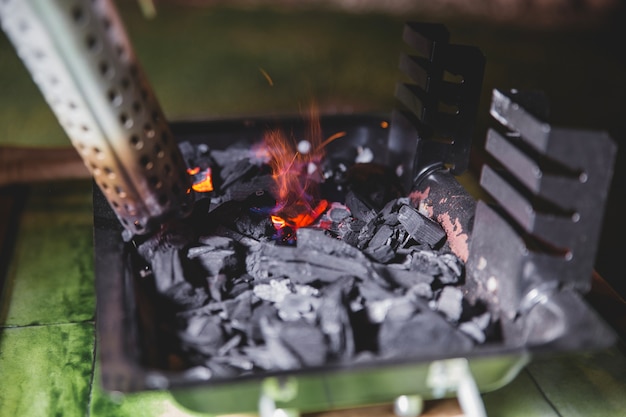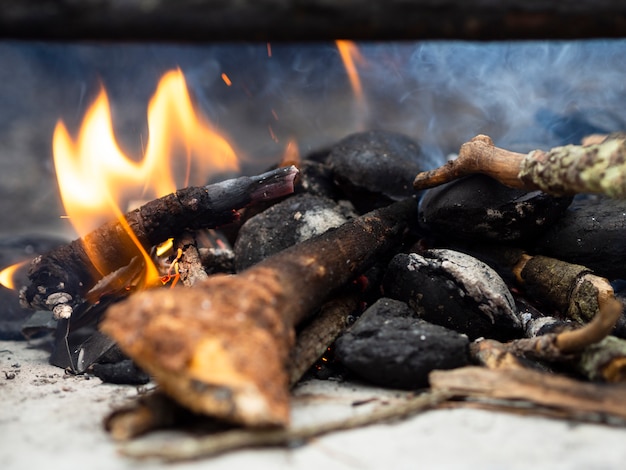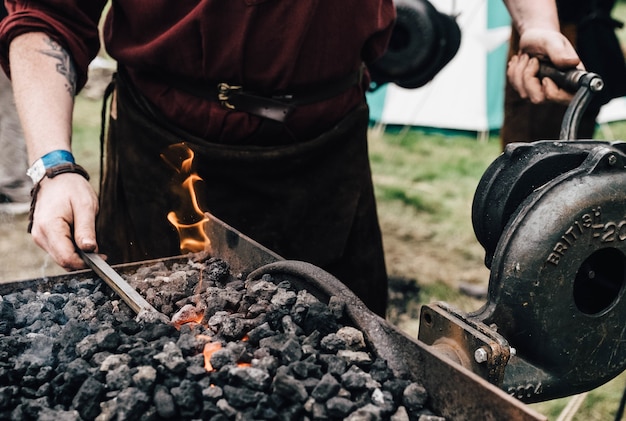How long does a charcoal BBQ take to heat up?
If you’re planning on firing up your charcoal BBQ for a backyard cookout, one of the most important factors to consider is how long it will take for the grill to heat up. The time it takes for a charcoal BBQ to reach its optimal grilling temperature can vary depending on several factors, including the type and quality of charcoal used, the size of the grill, and the weather conditions. However, with the right techniques and preparation, you can ensure your charcoal BBQ heats up efficiently and quickly.
Factors Affecting Heat-Up Time
Type and Quality of Charcoal: The type and quality of charcoal you use can greatly impact the time it takes for your BBQ to heat up. Lump charcoal, which consists of charred wood chunks, tends to heat up faster than briquettes, which are compressed charcoal blocks mixed with other ingredients. Additionally, high-quality charcoal tends to burn more evenly and produce higher temperatures compared to lower-quality options.
Grill Size: The size of your charcoal grill also plays a role in the heat-up time. Smaller grills will generally heat up faster than larger ones, as they require less time to distribute the heat evenly across the cooking surface. However, larger grills often have better heat retention capabilities, which can help maintain consistent temperatures once the desired heat is achieved.
Weather Conditions: Weather conditions, particularly wind and ambient temperature, can affect how quickly your charcoal BBQ heats up. Windy conditions can cause the coals to burn faster, resulting in a quicker heat-up time. On the other hand, cold temperatures may slow down the rate at which the charcoal ignites and reaches the desired temperature.
Methods for Faster Heat-up
Using a Chimney Starter: One of the most efficient ways to speed up the heat-up process is by using a chimney starter. This simple device allows you to ignite the charcoal evenly, using newspaper or firelighters placed at the bottom. As the coals catch fire, hot air rises through the chimney, heating up the charcoal quickly and evenly. Once the coals are glowing red and covered in white ash, they are ready to be spread across the grill for cooking.
Arranging the Charcoal: The way you arrange the charcoal in your grill can also affect the heat-up time. For faster heating, consider placing the coals in a concentrated pile or pyramid shape. This arrangement promotes better airflow and helps the coals ignite more efficiently.
Estimated Heat-up Times
While there is no definitive answer to how long it takes for a charcoal BBQ to heat up, here are some general estimates based on various factors:
- Using a chimney starter: Approximately 15-20 minutes.
- Using briquettes: Around 20-30 minutes.
- Using lump charcoal: Typically 10-15 minutes.
Please note that these times are not set in stone and can vary depending on the specific conditions mentioned earlier. It’s always best to use a reliable meat thermometer to ensure your food reaches the appropriate internal temperature during cooking.
In the world of grilling, patience is a virtue. While it can be tempting to rush the heat-up process, taking the time to properly heat your charcoal BBQ will yield better results in terms of flavor and even cooking.
In conclusion, the time it takes for a charcoal BBQ to heat up depends on several factors, including the type of charcoal used, grill size, and weather conditions. By using a chimney starter, arranging the charcoal effectively, and accounting for estimated heat-up times, you can ensure a quicker and more efficient heating process. Remember to prioritize safety, allow the coals to reach the right temperature, and enjoy the delicious results of your patience and preparation.
How do you know when your charcoal is ready?
Grilling outdoors is a popular pastime in the UK, especially during the summer months. Whether you’re cooking burgers, sausages, or vegetables, using charcoal can enhance the flavor of your food. But how do you know when your charcoal is ready for cooking? Here are some tips to ensure your charcoal is properly heated:
1. Lighting the charcoal
Before you can determine if your charcoal is ready, you need to light it. There are various methods to choose from, such as using lighter fluid, a chimney starter, or natural fire starters. Once your charcoal is ignited, you can move on to the next step.
2. Wait for the charcoal to ash over
Once the flames die down and the charcoal begins to turn grayish-white, it’s an indication that your charcoal is ready. The process usually takes around 20-30 minutes, depending on the type and amount of charcoal used. Avoid cooking over direct flames as this can result in unevenly cooked food.
3. Check the temperature
An easy way to test if your charcoal is ready is by checking the temperature. Using a grill thermometer, measure the heat at the cooking surface. For high heat, you should aim for around 400-450°F (200-230°C) for searing steaks or chicken. For a medium heat, target 350-375°F (175-190°C) for grilling burgers or fish fillets.
4. The hand test
For those who prefer a hands-on approach, you can use the hand test to determine the heat of your charcoal. Hold your hand about 5 inches above the cooking surface and count the number of seconds you can keep your hand there comfortably. Approximately 2-3 seconds indicates high heat, 4-5 seconds suggests medium heat, and 6-7 seconds is a sign of low heat.
Remember to always prioritize safety when working with hot charcoal. Use heat-resistant gloves and avoid touching the grill surface directly.
By following these steps, you can ensure that your charcoal is ready for cooking delicious meals on your barbecue. Happy grilling!
Can you cook on charcoal before it turns gray?
One common question that often arises when cooking with charcoal is whether it is safe and effective to start cooking before the charcoal has turned completely gray. Let’s delve into this topic and find out the answer!
The importance of charcoal color
Charcoal briquettes typically start off black but turn gray as they heat up. This change in color signifies that the briquettes are becoming fully ignited and reaching their optimal cooking temperature. The gray ash coating acts as an insulator, allowing for even heat distribution and a more controlled cooking process.
Advantages of waiting for gray charcoal
While it may be tempting to start cooking as soon as the charcoal is lit, there are several advantages to waiting until it turns gray:
- Better heat distribution: Gray charcoal indicates that the briquettes have reached their peak temperature, ensuring a consistent cooking experience.
- Reduced off-flavors: Cooking on fully ignited charcoal helps eliminate any residual chemicals or impurities from the briquettes, resulting in a cleaner taste.
- More efficient cooking: Gray charcoal burns more evenly and efficiently, providing a longer-lasting heat source for extended cooking sessions.
Is it safe to cook on black charcoal?
While it is technically safe to cook on black charcoal, it is not ideal. The briquettes may not have reached their optimal temperature, leading to unevenly cooked food and potential health risks.
“Cooking on gray charcoal ensures better heat distribution, reduced off-flavors, and more efficient cooking.”
So, it is generally recommended to wait for the charcoal to turn gray before placing your food on the grill. This allows for a more enjoyable and controlled cooking experience.
To sum up, waiting for charcoal to turn gray is not just a matter of aesthetics but also plays a crucial role in achieving optimal cooking results. Patience is key when it comes to grilling with charcoal, ensuring that your food is cooked to perfection.
How many hours does charcoal last?
Charcoal is a popular fuel choice for barbecuing and grilling, known for its ability to provide high heat and a distinct smoky flavor to food. One common question that arises when using charcoal is how long it lasts and how many hours of cooking you can expect from a bag or a specific quantity of charcoal. The duration for which charcoal lasts depends on various factors, including the type of charcoal being used, the grill setup, and the cooking techniques employed.
Type of Charcoal
There are two main types of charcoal available: briquettes and lump charcoal. Briquettes are compressed charcoal dust and other ingredients, while lump charcoal is made from pure wood pieces. Briquettes typically burn longer and more consistently compared to lump charcoal. On average, a standard 12 kg bag of briquettes can last approximately 8-10 hours of grilling time, whereas the same quantity of lump charcoal may last around 5-7 hours.
Grill Setup and Cooking Techniques
The efficiency and duration of charcoal also depend on the grill setup and the cooking techniques employed. A well-designed grill with proper ventilation allows for better airflow and control of the charcoal’s burn rate. Additionally, the way you arrange the coals in the grill can impact heat distribution and the longevity of the fuel.
Cooking techniques, such as direct grilling or indirect grilling, also affect the burn time. Direct grilling, where the food is cooked directly over the coals, tends to consume more charcoal and offers shorter cooking times. On the other hand, indirect grilling, where the coals are placed to the side and the food is cooked indirectly, can result in longer burning and cooking times.
Factors Affecting Burn Time
Several factors can influence the burn time of charcoal. These include weather conditions, such as wind and ambient temperature, as well as the size and quality of the charcoal pieces. In windy conditions, the coals burn faster due to increased oxygen supply. Similarly, cold temperatures may slow down the burning process.
It is important to note that these are general estimates, and actual burn times may vary depending on several variables. It is always recommended to maintain a spare bag of charcoal when grilling or barbecuing to ensure uninterrupted cooking, especially for longer cooking sessions.
How do you make a charcoal fire last longer?
Having a long-lasting charcoal fire is essential for a successful barbecue. It ensures that your food cooks evenly and gives you more time to enjoy the experience with friends and family. To help you achieve this, we have compiled some tips on how to make a charcoal fire last longer:
1. Start with the right amount of charcoal
It’s important to use the right amount of charcoal to create a long-lasting fire. Too little charcoal can burn out quickly, while too much can smother the fire. As a general rule, fill your grill with a single layer of charcoal briquettes or arrange them in a pyramid shape for better airflow.
2. Use a chimney starter
A chimney starter is an efficient way to light your charcoal without the need for lighter fluid. It allows for even heat distribution and helps the coals burn evenly. Simply fill the chimney starter with charcoal, place some crumpled newspaper underneath, and light it. Once the coals are fully lit and covered with ash, carefully transfer them to your grill.
3. Control the airflow
Proper airflow is crucial for maintaining a steady and long-lasting fire. Make sure to adjust the vents on your grill to regulate the intake of oxygen. Opening the vents wide will increase the heat, while closing them partially will lower the temperature. This control over airflow helps in conserving the charcoal and extending its burn time.
4. Arrange the charcoal strategically
How you arrange your charcoal can also affect its burn time. Placing the coals closer together will create a hotter fire, while spreading them out will result in a slower burn. Consider using the two-zone method by piling the coals on one side of the grill and leaving the other side empty. This provides both direct and indirect heat, allowing you to cook various foods simultaneously and conserve charcoal.
5. Minimize lid openings
Every time you open the lid of your grill, you let out heat and oxygen, which can shorten the burn time of your charcoal. To maximize the longevity of your fire, limit lid openings to only when necessary. Plan your cooking process in advance, ensuring you have all the tools and ingredients ready to minimize the need for frequent lid adjustments.
By following these tips, you can make your charcoal fire last longer, giving you more time to savor the delicious flavors of your barbecued food. Enjoy your grilling experience!
How do you increase charcoal fire?
Grilling on a charcoal barbecue is a beloved tradition in the UK, but sometimes getting the fire started and maintaining a steady heat can be a challenge. Luckily, there are a few tips and tricks you can use to increase the intensity of your charcoal fire and achieve that perfect sear on your meats and vegetables.
1. Use quality charcoal
The type of charcoal you use can make a significant difference in the intensity of your fire. Opt for lump charcoal or briquettes made from hardwood, as they tend to burn hotter and longer than cheaper alternatives.
2. Arrange the charcoal properly
Properly arranging the charcoal in your grill can help increase the fire’s intensity. Create a pyramid-shaped pile of charcoal and leave some space in the center for air flow. This arrangement allows for better oxygen circulation, leading to a hotter fire.
3. Add lighter fluid or chimney starter
If you’re struggling to get your fire going, you can use lighter fluid or a chimney starter to give it a boost. Lighter fluid should be used sparingly, as using too much can leave a chemical taste on your food. A chimney starter is a safer option, as it uses newspaper to ignite the charcoal without any added chemicals.
4. Wait for the charcoal to ash over
Before you start grilling, make sure to wait until the charcoal has turned grayish-white and developed a layer of ash. This indicates that the charcoal is hot and ready for cooking. Trying to grill on partially lit charcoal can result in uneven heat distribution and undercooked food.
5. Use the right vents
Your barbecue grill should have vents that allow you to control the flow of air. Opening the vents wide will increase the airflow and intensify the fire, while closing them partially will reduce the heat. Experiment with the vent settings to achieve the desired level of intensity for your cooking.
Remember, safety should always be a priority when dealing with fire. Follow the manufacturer’s instructions for your grill and never leave it unattended.
By following these tips, you can increase the intensity of your charcoal fire and take your grilling to the next level. Enjoy experimenting with different techniques to find what works best for you and your barbecue.


